Developing Leaders, Individuals, and Organizations: Strategies
VerifiedAdded on 2023/06/03
|19
|6460
|478
Report
AI Summary
This report examines strategies for developing leaders, individuals, and organizations within a business context, emphasizing the importance of human resource development for profit maximization. It highlights the roles of managers in interpersonal communication, information processing, and decision-making, and identifies key business needs such as cash flow management, data-driven culture, lean planning, margin analysis, and strategic hiring. The report suggests interventions including evaluating team strengths and weaknesses and adapting to different learning styles to ensure effective training. It also touches on the costs and projected benefits of these developmental interventions, aiming to transform managers into effective coaches who can drive positive change within the workplace. Desklib offers a platform for students to access past papers and solved assignments related to this topic.
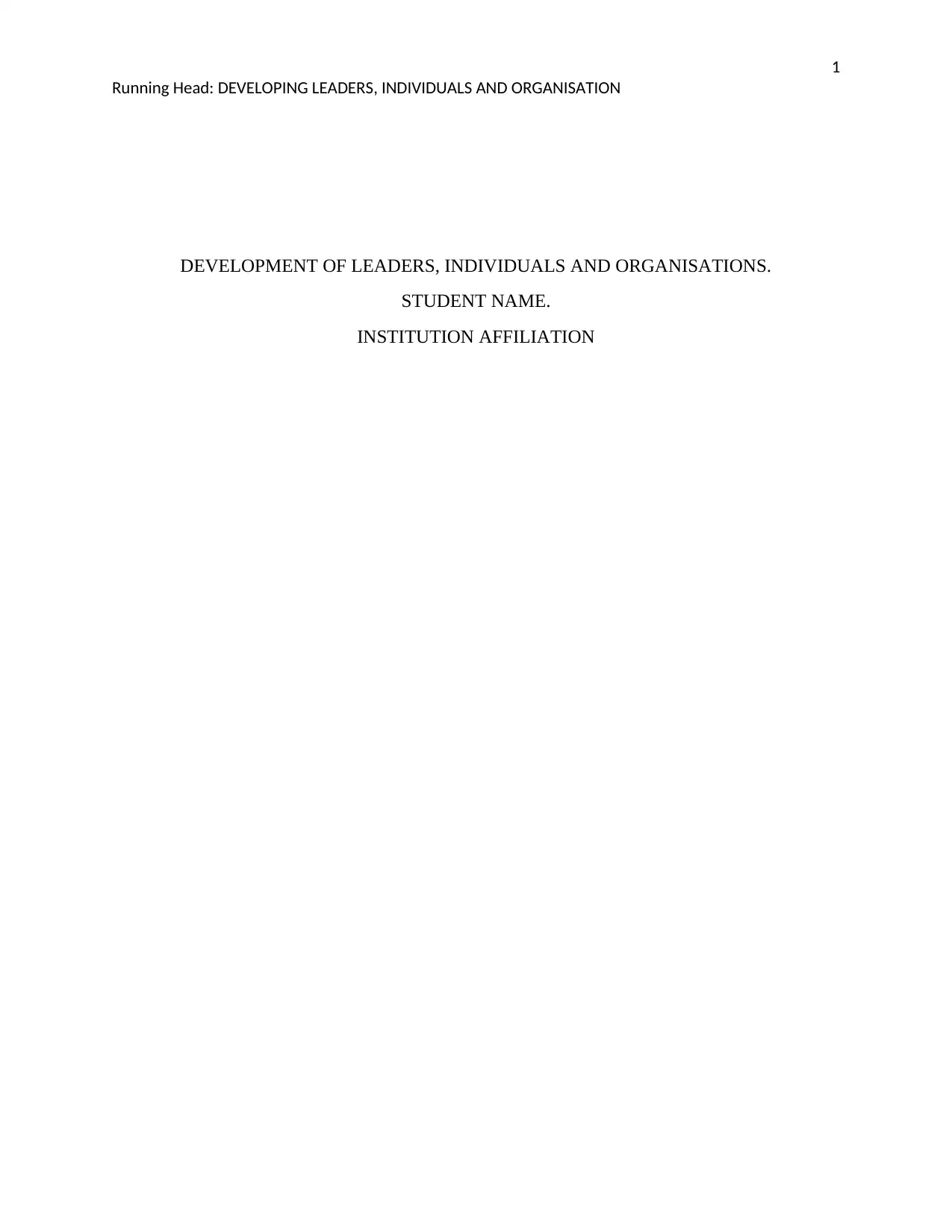
1
Running Head: DEVELOPING LEADERS, INDIVIDUALS AND ORGANISATION
DEVELOPMENT OF LEADERS, INDIVIDUALS AND ORGANISATIONS.
STUDENT NAME.
INSTITUTION AFFILIATION
Running Head: DEVELOPING LEADERS, INDIVIDUALS AND ORGANISATION
DEVELOPMENT OF LEADERS, INDIVIDUALS AND ORGANISATIONS.
STUDENT NAME.
INSTITUTION AFFILIATION
Paraphrase This Document
Need a fresh take? Get an instant paraphrase of this document with our AI Paraphraser
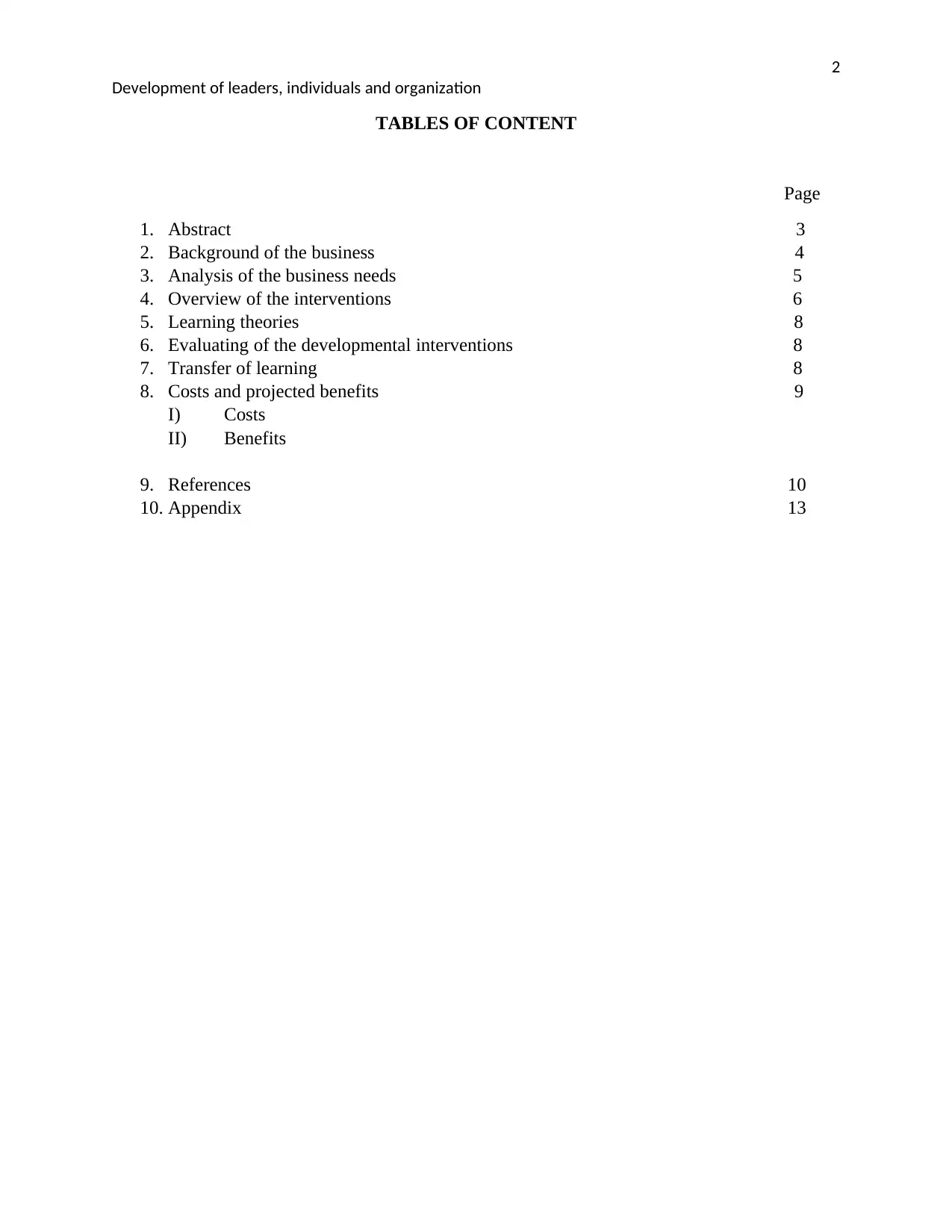
2
Development of leaders, individuals and organization
TABLES OF CONTENT
Page
1. Abstract 3
2. Background of the business 4
3. Analysis of the business needs 5
4. Overview of the interventions 6
5. Learning theories 8
6. Evaluating of the developmental interventions 8
7. Transfer of learning 8
8. Costs and projected benefits 9
I) Costs
II) Benefits
9. References 10
10. Appendix 13
Development of leaders, individuals and organization
TABLES OF CONTENT
Page
1. Abstract 3
2. Background of the business 4
3. Analysis of the business needs 5
4. Overview of the interventions 6
5. Learning theories 8
6. Evaluating of the developmental interventions 8
7. Transfer of learning 8
8. Costs and projected benefits 9
I) Costs
II) Benefits
9. References 10
10. Appendix 13
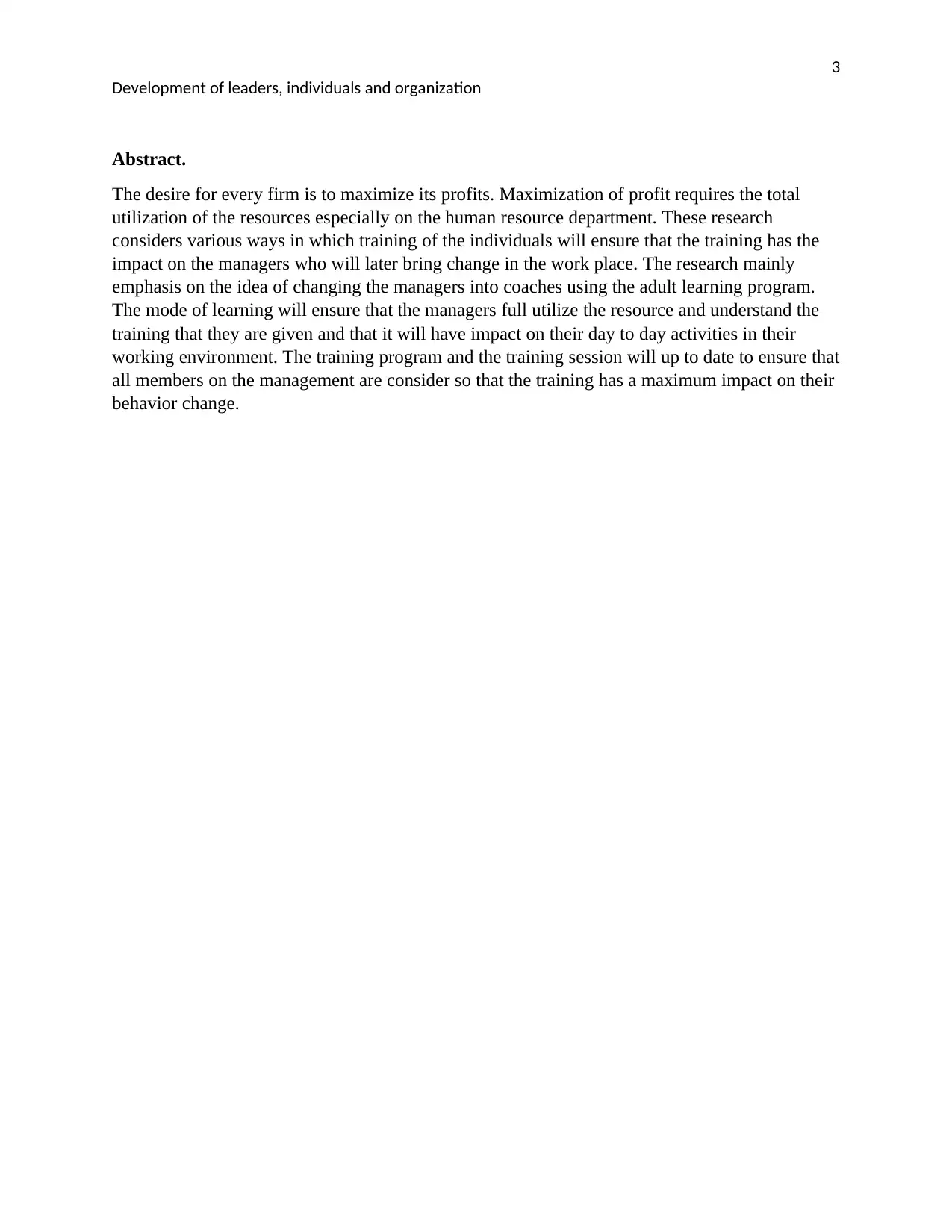
3
Development of leaders, individuals and organization
Abstract.
The desire for every firm is to maximize its profits. Maximization of profit requires the total
utilization of the resources especially on the human resource department. These research
considers various ways in which training of the individuals will ensure that the training has the
impact on the managers who will later bring change in the work place. The research mainly
emphasis on the idea of changing the managers into coaches using the adult learning program.
The mode of learning will ensure that the managers full utilize the resource and understand the
training that they are given and that it will have impact on their day to day activities in their
working environment. The training program and the training session will up to date to ensure that
all members on the management are consider so that the training has a maximum impact on their
behavior change.
Development of leaders, individuals and organization
Abstract.
The desire for every firm is to maximize its profits. Maximization of profit requires the total
utilization of the resources especially on the human resource department. These research
considers various ways in which training of the individuals will ensure that the training has the
impact on the managers who will later bring change in the work place. The research mainly
emphasis on the idea of changing the managers into coaches using the adult learning program.
The mode of learning will ensure that the managers full utilize the resource and understand the
training that they are given and that it will have impact on their day to day activities in their
working environment. The training program and the training session will up to date to ensure that
all members on the management are consider so that the training has a maximum impact on their
behavior change.
⊘ This is a preview!⊘
Do you want full access?
Subscribe today to unlock all pages.

Trusted by 1+ million students worldwide
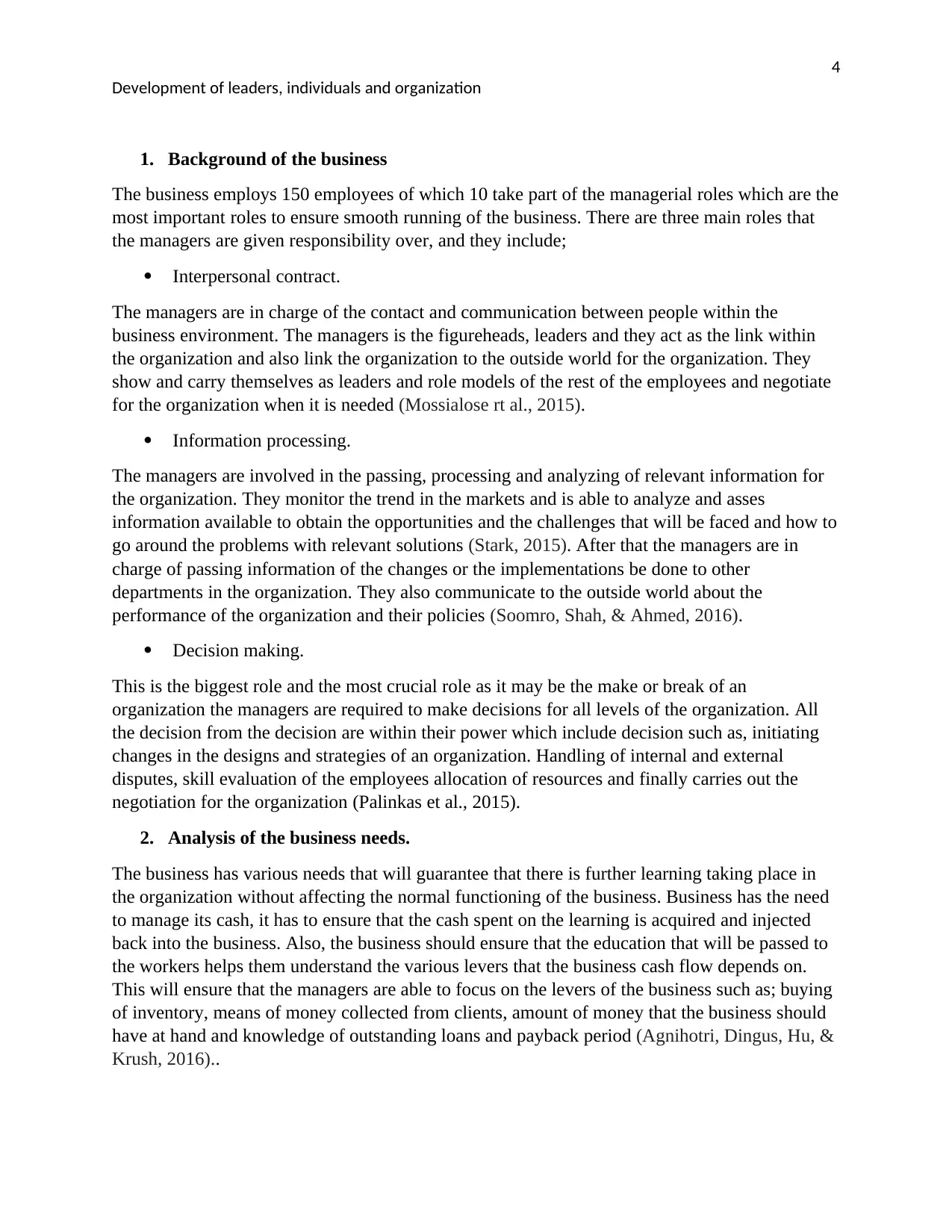
4
Development of leaders, individuals and organization
1. Background of the business
The business employs 150 employees of which 10 take part of the managerial roles which are the
most important roles to ensure smooth running of the business. There are three main roles that
the managers are given responsibility over, and they include;
Interpersonal contract.
The managers are in charge of the contact and communication between people within the
business environment. The managers is the figureheads, leaders and they act as the link within
the organization and also link the organization to the outside world for the organization. They
show and carry themselves as leaders and role models of the rest of the employees and negotiate
for the organization when it is needed (Mossialose rt al., 2015).
Information processing.
The managers are involved in the passing, processing and analyzing of relevant information for
the organization. They monitor the trend in the markets and is able to analyze and asses
information available to obtain the opportunities and the challenges that will be faced and how to
go around the problems with relevant solutions (Stark, 2015). After that the managers are in
charge of passing information of the changes or the implementations be done to other
departments in the organization. They also communicate to the outside world about the
performance of the organization and their policies (Soomro, Shah, & Ahmed, 2016).
Decision making.
This is the biggest role and the most crucial role as it may be the make or break of an
organization the managers are required to make decisions for all levels of the organization. All
the decision from the decision are within their power which include decision such as, initiating
changes in the designs and strategies of an organization. Handling of internal and external
disputes, skill evaluation of the employees allocation of resources and finally carries out the
negotiation for the organization (Palinkas et al., 2015).
2. Analysis of the business needs.
The business has various needs that will guarantee that there is further learning taking place in
the organization without affecting the normal functioning of the business. Business has the need
to manage its cash, it has to ensure that the cash spent on the learning is acquired and injected
back into the business. Also, the business should ensure that the education that will be passed to
the workers helps them understand the various levers that the business cash flow depends on.
This will ensure that the managers are able to focus on the levers of the business such as; buying
of inventory, means of money collected from clients, amount of money that the business should
have at hand and knowledge of outstanding loans and payback period (Agnihotri, Dingus, Hu, &
Krush, 2016)..
Development of leaders, individuals and organization
1. Background of the business
The business employs 150 employees of which 10 take part of the managerial roles which are the
most important roles to ensure smooth running of the business. There are three main roles that
the managers are given responsibility over, and they include;
Interpersonal contract.
The managers are in charge of the contact and communication between people within the
business environment. The managers is the figureheads, leaders and they act as the link within
the organization and also link the organization to the outside world for the organization. They
show and carry themselves as leaders and role models of the rest of the employees and negotiate
for the organization when it is needed (Mossialose rt al., 2015).
Information processing.
The managers are involved in the passing, processing and analyzing of relevant information for
the organization. They monitor the trend in the markets and is able to analyze and asses
information available to obtain the opportunities and the challenges that will be faced and how to
go around the problems with relevant solutions (Stark, 2015). After that the managers are in
charge of passing information of the changes or the implementations be done to other
departments in the organization. They also communicate to the outside world about the
performance of the organization and their policies (Soomro, Shah, & Ahmed, 2016).
Decision making.
This is the biggest role and the most crucial role as it may be the make or break of an
organization the managers are required to make decisions for all levels of the organization. All
the decision from the decision are within their power which include decision such as, initiating
changes in the designs and strategies of an organization. Handling of internal and external
disputes, skill evaluation of the employees allocation of resources and finally carries out the
negotiation for the organization (Palinkas et al., 2015).
2. Analysis of the business needs.
The business has various needs that will guarantee that there is further learning taking place in
the organization without affecting the normal functioning of the business. Business has the need
to manage its cash, it has to ensure that the cash spent on the learning is acquired and injected
back into the business. Also, the business should ensure that the education that will be passed to
the workers helps them understand the various levers that the business cash flow depends on.
This will ensure that the managers are able to focus on the levers of the business such as; buying
of inventory, means of money collected from clients, amount of money that the business should
have at hand and knowledge of outstanding loans and payback period (Agnihotri, Dingus, Hu, &
Krush, 2016)..
Paraphrase This Document
Need a fresh take? Get an instant paraphrase of this document with our AI Paraphraser
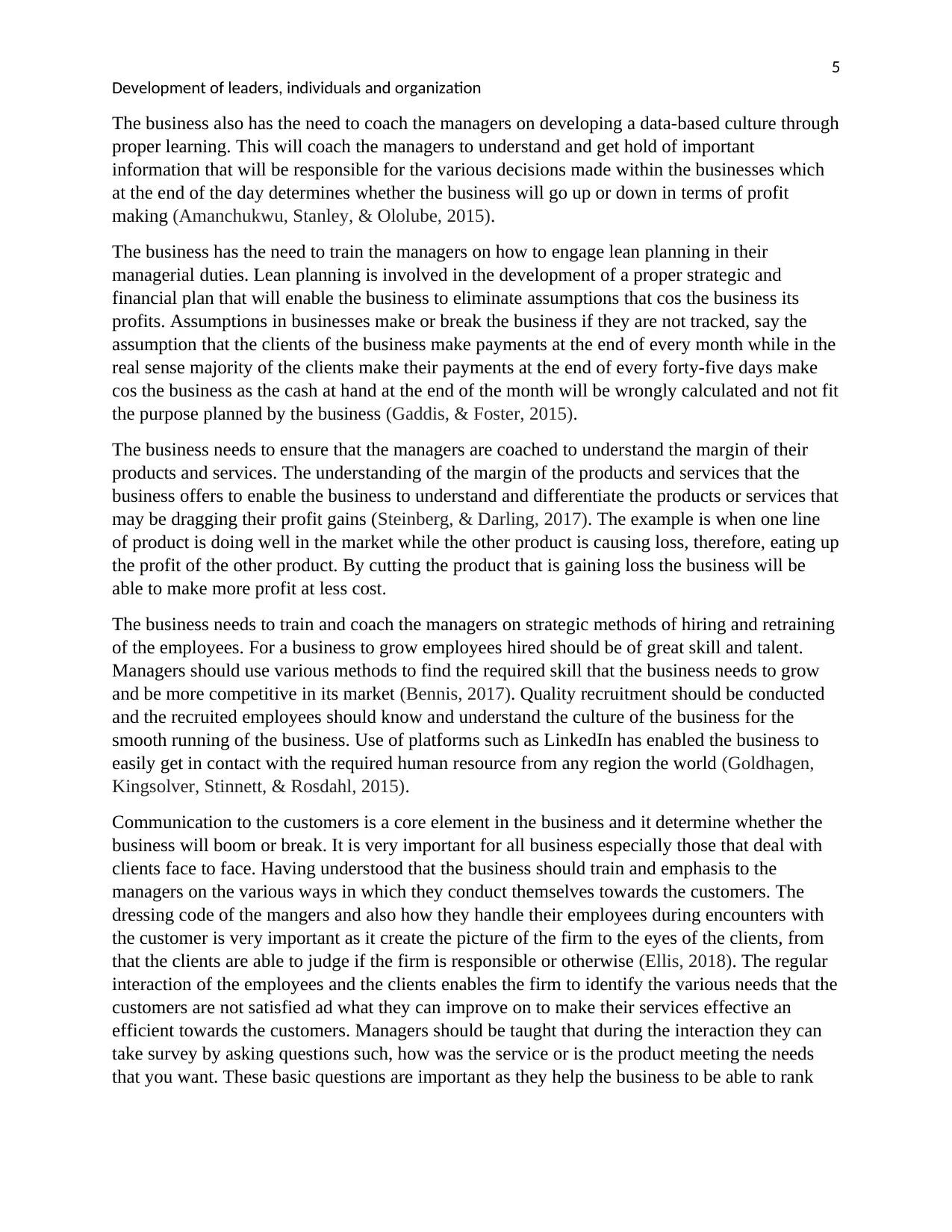
5
Development of leaders, individuals and organization
The business also has the need to coach the managers on developing a data-based culture through
proper learning. This will coach the managers to understand and get hold of important
information that will be responsible for the various decisions made within the businesses which
at the end of the day determines whether the business will go up or down in terms of profit
making (Amanchukwu, Stanley, & Ololube, 2015).
The business has the need to train the managers on how to engage lean planning in their
managerial duties. Lean planning is involved in the development of a proper strategic and
financial plan that will enable the business to eliminate assumptions that cos the business its
profits. Assumptions in businesses make or break the business if they are not tracked, say the
assumption that the clients of the business make payments at the end of every month while in the
real sense majority of the clients make their payments at the end of every forty-five days make
cos the business as the cash at hand at the end of the month will be wrongly calculated and not fit
the purpose planned by the business (Gaddis, & Foster, 2015).
The business needs to ensure that the managers are coached to understand the margin of their
products and services. The understanding of the margin of the products and services that the
business offers to enable the business to understand and differentiate the products or services that
may be dragging their profit gains (Steinberg, & Darling, 2017). The example is when one line
of product is doing well in the market while the other product is causing loss, therefore, eating up
the profit of the other product. By cutting the product that is gaining loss the business will be
able to make more profit at less cost.
The business needs to train and coach the managers on strategic methods of hiring and retraining
of the employees. For a business to grow employees hired should be of great skill and talent.
Managers should use various methods to find the required skill that the business needs to grow
and be more competitive in its market (Bennis, 2017). Quality recruitment should be conducted
and the recruited employees should know and understand the culture of the business for the
smooth running of the business. Use of platforms such as LinkedIn has enabled the business to
easily get in contact with the required human resource from any region the world (Goldhagen,
Kingsolver, Stinnett, & Rosdahl, 2015).
Communication to the customers is a core element in the business and it determine whether the
business will boom or break. It is very important for all business especially those that deal with
clients face to face. Having understood that the business should train and emphasis to the
managers on the various ways in which they conduct themselves towards the customers. The
dressing code of the mangers and also how they handle their employees during encounters with
the customer is very important as it create the picture of the firm to the eyes of the clients, from
that the clients are able to judge if the firm is responsible or otherwise (Ellis, 2018). The regular
interaction of the employees and the clients enables the firm to identify the various needs that the
customers are not satisfied ad what they can improve on to make their services effective an
efficient towards the customers. Managers should be taught that during the interaction they can
take survey by asking questions such, how was the service or is the product meeting the needs
that you want. These basic questions are important as they help the business to be able to rank
Development of leaders, individuals and organization
The business also has the need to coach the managers on developing a data-based culture through
proper learning. This will coach the managers to understand and get hold of important
information that will be responsible for the various decisions made within the businesses which
at the end of the day determines whether the business will go up or down in terms of profit
making (Amanchukwu, Stanley, & Ololube, 2015).
The business has the need to train the managers on how to engage lean planning in their
managerial duties. Lean planning is involved in the development of a proper strategic and
financial plan that will enable the business to eliminate assumptions that cos the business its
profits. Assumptions in businesses make or break the business if they are not tracked, say the
assumption that the clients of the business make payments at the end of every month while in the
real sense majority of the clients make their payments at the end of every forty-five days make
cos the business as the cash at hand at the end of the month will be wrongly calculated and not fit
the purpose planned by the business (Gaddis, & Foster, 2015).
The business needs to ensure that the managers are coached to understand the margin of their
products and services. The understanding of the margin of the products and services that the
business offers to enable the business to understand and differentiate the products or services that
may be dragging their profit gains (Steinberg, & Darling, 2017). The example is when one line
of product is doing well in the market while the other product is causing loss, therefore, eating up
the profit of the other product. By cutting the product that is gaining loss the business will be
able to make more profit at less cost.
The business needs to train and coach the managers on strategic methods of hiring and retraining
of the employees. For a business to grow employees hired should be of great skill and talent.
Managers should use various methods to find the required skill that the business needs to grow
and be more competitive in its market (Bennis, 2017). Quality recruitment should be conducted
and the recruited employees should know and understand the culture of the business for the
smooth running of the business. Use of platforms such as LinkedIn has enabled the business to
easily get in contact with the required human resource from any region the world (Goldhagen,
Kingsolver, Stinnett, & Rosdahl, 2015).
Communication to the customers is a core element in the business and it determine whether the
business will boom or break. It is very important for all business especially those that deal with
clients face to face. Having understood that the business should train and emphasis to the
managers on the various ways in which they conduct themselves towards the customers. The
dressing code of the mangers and also how they handle their employees during encounters with
the customer is very important as it create the picture of the firm to the eyes of the clients, from
that the clients are able to judge if the firm is responsible or otherwise (Ellis, 2018). The regular
interaction of the employees and the clients enables the firm to identify the various needs that the
customers are not satisfied ad what they can improve on to make their services effective an
efficient towards the customers. Managers should be taught that during the interaction they can
take survey by asking questions such, how was the service or is the product meeting the needs
that you want. These basic questions are important as they help the business to be able to rank
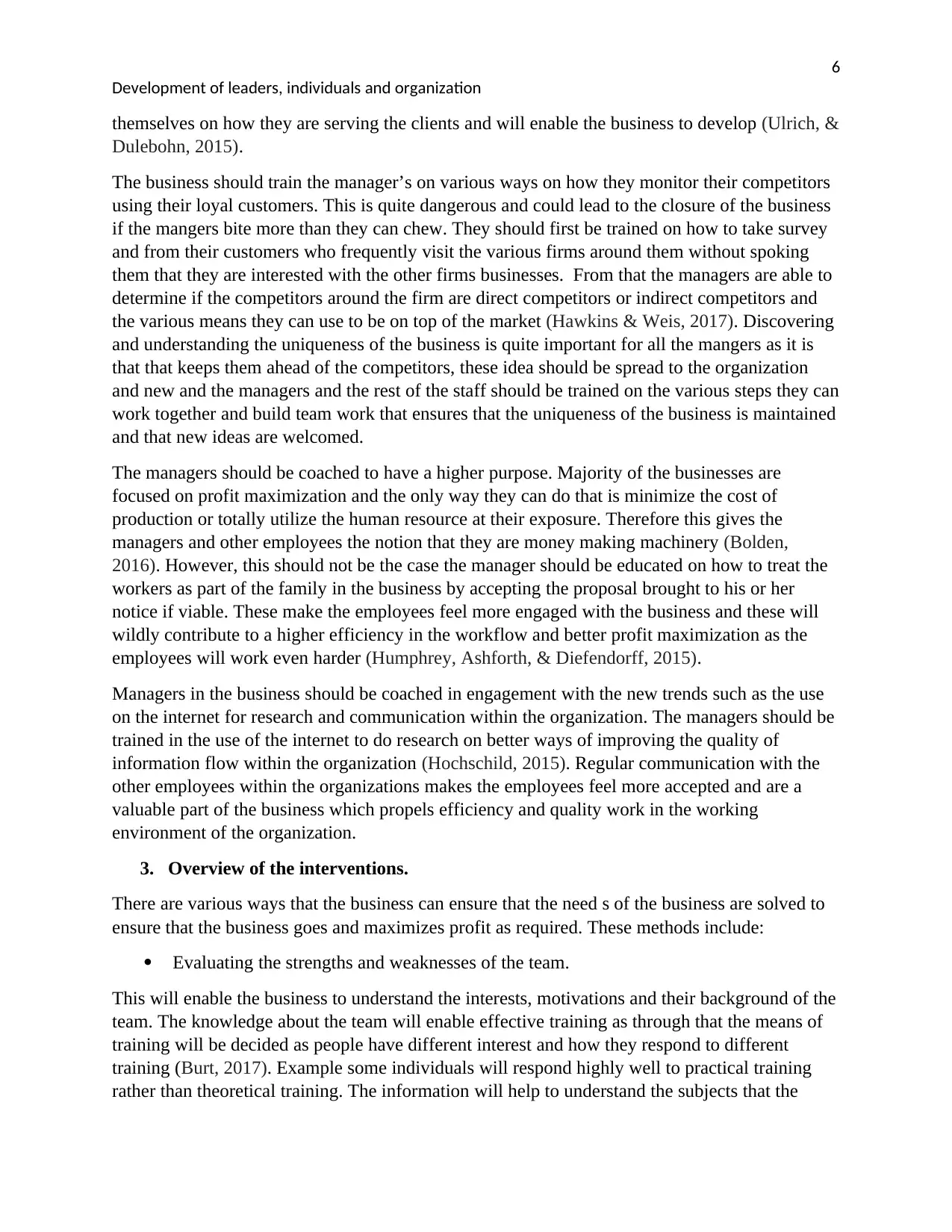
6
Development of leaders, individuals and organization
themselves on how they are serving the clients and will enable the business to develop (Ulrich, &
Dulebohn, 2015).
The business should train the manager’s on various ways on how they monitor their competitors
using their loyal customers. This is quite dangerous and could lead to the closure of the business
if the mangers bite more than they can chew. They should first be trained on how to take survey
and from their customers who frequently visit the various firms around them without spoking
them that they are interested with the other firms businesses. From that the managers are able to
determine if the competitors around the firm are direct competitors or indirect competitors and
the various means they can use to be on top of the market (Hawkins & Weis, 2017). Discovering
and understanding the uniqueness of the business is quite important for all the mangers as it is
that that keeps them ahead of the competitors, these idea should be spread to the organization
and new and the managers and the rest of the staff should be trained on the various steps they can
work together and build team work that ensures that the uniqueness of the business is maintained
and that new ideas are welcomed.
The managers should be coached to have a higher purpose. Majority of the businesses are
focused on profit maximization and the only way they can do that is minimize the cost of
production or totally utilize the human resource at their exposure. Therefore this gives the
managers and other employees the notion that they are money making machinery (Bolden,
2016). However, this should not be the case the manager should be educated on how to treat the
workers as part of the family in the business by accepting the proposal brought to his or her
notice if viable. These make the employees feel more engaged with the business and these will
wildly contribute to a higher efficiency in the workflow and better profit maximization as the
employees will work even harder (Humphrey, Ashforth, & Diefendorff, 2015).
Managers in the business should be coached in engagement with the new trends such as the use
on the internet for research and communication within the organization. The managers should be
trained in the use of the internet to do research on better ways of improving the quality of
information flow within the organization (Hochschild, 2015). Regular communication with the
other employees within the organizations makes the employees feel more accepted and are a
valuable part of the business which propels efficiency and quality work in the working
environment of the organization.
3. Overview of the interventions.
There are various ways that the business can ensure that the need s of the business are solved to
ensure that the business goes and maximizes profit as required. These methods include:
Evaluating the strengths and weaknesses of the team.
This will enable the business to understand the interests, motivations and their background of the
team. The knowledge about the team will enable effective training as through that the means of
training will be decided as people have different interest and how they respond to different
training (Burt, 2017). Example some individuals will respond highly well to practical training
rather than theoretical training. The information will help to understand the subjects that the
Development of leaders, individuals and organization
themselves on how they are serving the clients and will enable the business to develop (Ulrich, &
Dulebohn, 2015).
The business should train the manager’s on various ways on how they monitor their competitors
using their loyal customers. This is quite dangerous and could lead to the closure of the business
if the mangers bite more than they can chew. They should first be trained on how to take survey
and from their customers who frequently visit the various firms around them without spoking
them that they are interested with the other firms businesses. From that the managers are able to
determine if the competitors around the firm are direct competitors or indirect competitors and
the various means they can use to be on top of the market (Hawkins & Weis, 2017). Discovering
and understanding the uniqueness of the business is quite important for all the mangers as it is
that that keeps them ahead of the competitors, these idea should be spread to the organization
and new and the managers and the rest of the staff should be trained on the various steps they can
work together and build team work that ensures that the uniqueness of the business is maintained
and that new ideas are welcomed.
The managers should be coached to have a higher purpose. Majority of the businesses are
focused on profit maximization and the only way they can do that is minimize the cost of
production or totally utilize the human resource at their exposure. Therefore this gives the
managers and other employees the notion that they are money making machinery (Bolden,
2016). However, this should not be the case the manager should be educated on how to treat the
workers as part of the family in the business by accepting the proposal brought to his or her
notice if viable. These make the employees feel more engaged with the business and these will
wildly contribute to a higher efficiency in the workflow and better profit maximization as the
employees will work even harder (Humphrey, Ashforth, & Diefendorff, 2015).
Managers in the business should be coached in engagement with the new trends such as the use
on the internet for research and communication within the organization. The managers should be
trained in the use of the internet to do research on better ways of improving the quality of
information flow within the organization (Hochschild, 2015). Regular communication with the
other employees within the organizations makes the employees feel more accepted and are a
valuable part of the business which propels efficiency and quality work in the working
environment of the organization.
3. Overview of the interventions.
There are various ways that the business can ensure that the need s of the business are solved to
ensure that the business goes and maximizes profit as required. These methods include:
Evaluating the strengths and weaknesses of the team.
This will enable the business to understand the interests, motivations and their background of the
team. The knowledge about the team will enable effective training as through that the means of
training will be decided as people have different interest and how they respond to different
training (Burt, 2017). Example some individuals will respond highly well to practical training
rather than theoretical training. The information will help to understand the subjects that the
⊘ This is a preview!⊘
Do you want full access?
Subscribe today to unlock all pages.

Trusted by 1+ million students worldwide
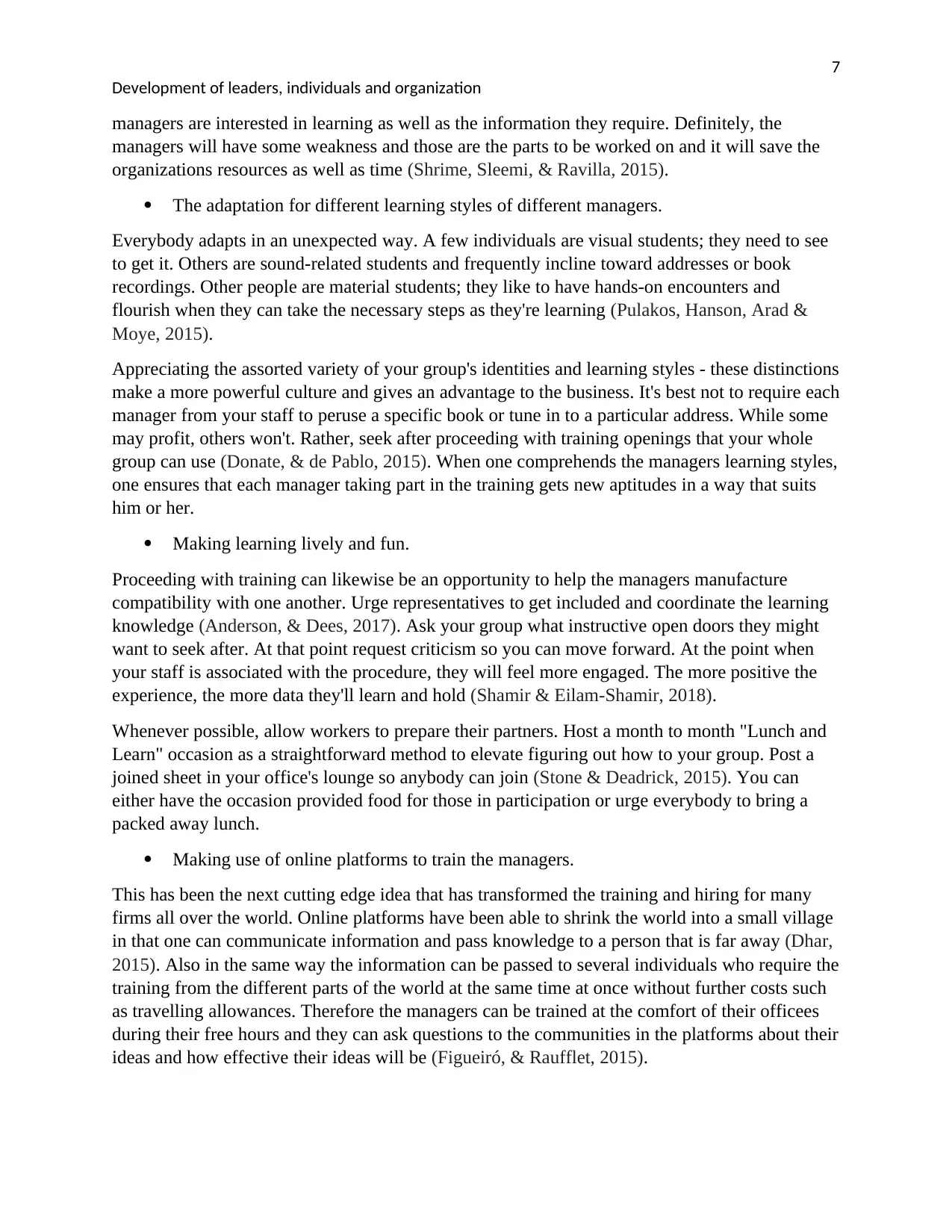
7
Development of leaders, individuals and organization
managers are interested in learning as well as the information they require. Definitely, the
managers will have some weakness and those are the parts to be worked on and it will save the
organizations resources as well as time (Shrime, Sleemi, & Ravilla, 2015).
The adaptation for different learning styles of different managers.
Everybody adapts in an unexpected way. A few individuals are visual students; they need to see
to get it. Others are sound-related students and frequently incline toward addresses or book
recordings. Other people are material students; they like to have hands-on encounters and
flourish when they can take the necessary steps as they're learning (Pulakos, Hanson, Arad &
Moye, 2015).
Appreciating the assorted variety of your group's identities and learning styles - these distinctions
make a more powerful culture and gives an advantage to the business. It's best not to require each
manager from your staff to peruse a specific book or tune in to a particular address. While some
may profit, others won't. Rather, seek after proceeding with training openings that your whole
group can use (Donate, & de Pablo, 2015). When one comprehends the managers learning styles,
one ensures that each manager taking part in the training gets new aptitudes in a way that suits
him or her.
Making learning lively and fun.
Proceeding with training can likewise be an opportunity to help the managers manufacture
compatibility with one another. Urge representatives to get included and coordinate the learning
knowledge (Anderson, & Dees, 2017). Ask your group what instructive open doors they might
want to seek after. At that point request criticism so you can move forward. At the point when
your staff is associated with the procedure, they will feel more engaged. The more positive the
experience, the more data they'll learn and hold (Shamir & Eilam-Shamir, 2018).
Whenever possible, allow workers to prepare their partners. Host a month to month "Lunch and
Learn" occasion as a straightforward method to elevate figuring out how to your group. Post a
joined sheet in your office's lounge so anybody can join (Stone & Deadrick, 2015). You can
either have the occasion provided food for those in participation or urge everybody to bring a
packed away lunch.
Making use of online platforms to train the managers.
This has been the next cutting edge idea that has transformed the training and hiring for many
firms all over the world. Online platforms have been able to shrink the world into a small village
in that one can communicate information and pass knowledge to a person that is far away (Dhar,
2015). Also in the same way the information can be passed to several individuals who require the
training from the different parts of the world at the same time at once without further costs such
as travelling allowances. Therefore the managers can be trained at the comfort of their officees
during their free hours and they can ask questions to the communities in the platforms about their
ideas and how effective their ideas will be (Figueiró, & Raufflet, 2015).
Development of leaders, individuals and organization
managers are interested in learning as well as the information they require. Definitely, the
managers will have some weakness and those are the parts to be worked on and it will save the
organizations resources as well as time (Shrime, Sleemi, & Ravilla, 2015).
The adaptation for different learning styles of different managers.
Everybody adapts in an unexpected way. A few individuals are visual students; they need to see
to get it. Others are sound-related students and frequently incline toward addresses or book
recordings. Other people are material students; they like to have hands-on encounters and
flourish when they can take the necessary steps as they're learning (Pulakos, Hanson, Arad &
Moye, 2015).
Appreciating the assorted variety of your group's identities and learning styles - these distinctions
make a more powerful culture and gives an advantage to the business. It's best not to require each
manager from your staff to peruse a specific book or tune in to a particular address. While some
may profit, others won't. Rather, seek after proceeding with training openings that your whole
group can use (Donate, & de Pablo, 2015). When one comprehends the managers learning styles,
one ensures that each manager taking part in the training gets new aptitudes in a way that suits
him or her.
Making learning lively and fun.
Proceeding with training can likewise be an opportunity to help the managers manufacture
compatibility with one another. Urge representatives to get included and coordinate the learning
knowledge (Anderson, & Dees, 2017). Ask your group what instructive open doors they might
want to seek after. At that point request criticism so you can move forward. At the point when
your staff is associated with the procedure, they will feel more engaged. The more positive the
experience, the more data they'll learn and hold (Shamir & Eilam-Shamir, 2018).
Whenever possible, allow workers to prepare their partners. Host a month to month "Lunch and
Learn" occasion as a straightforward method to elevate figuring out how to your group. Post a
joined sheet in your office's lounge so anybody can join (Stone & Deadrick, 2015). You can
either have the occasion provided food for those in participation or urge everybody to bring a
packed away lunch.
Making use of online platforms to train the managers.
This has been the next cutting edge idea that has transformed the training and hiring for many
firms all over the world. Online platforms have been able to shrink the world into a small village
in that one can communicate information and pass knowledge to a person that is far away (Dhar,
2015). Also in the same way the information can be passed to several individuals who require the
training from the different parts of the world at the same time at once without further costs such
as travelling allowances. Therefore the managers can be trained at the comfort of their officees
during their free hours and they can ask questions to the communities in the platforms about their
ideas and how effective their ideas will be (Figueiró, & Raufflet, 2015).
Paraphrase This Document
Need a fresh take? Get an instant paraphrase of this document with our AI Paraphraser
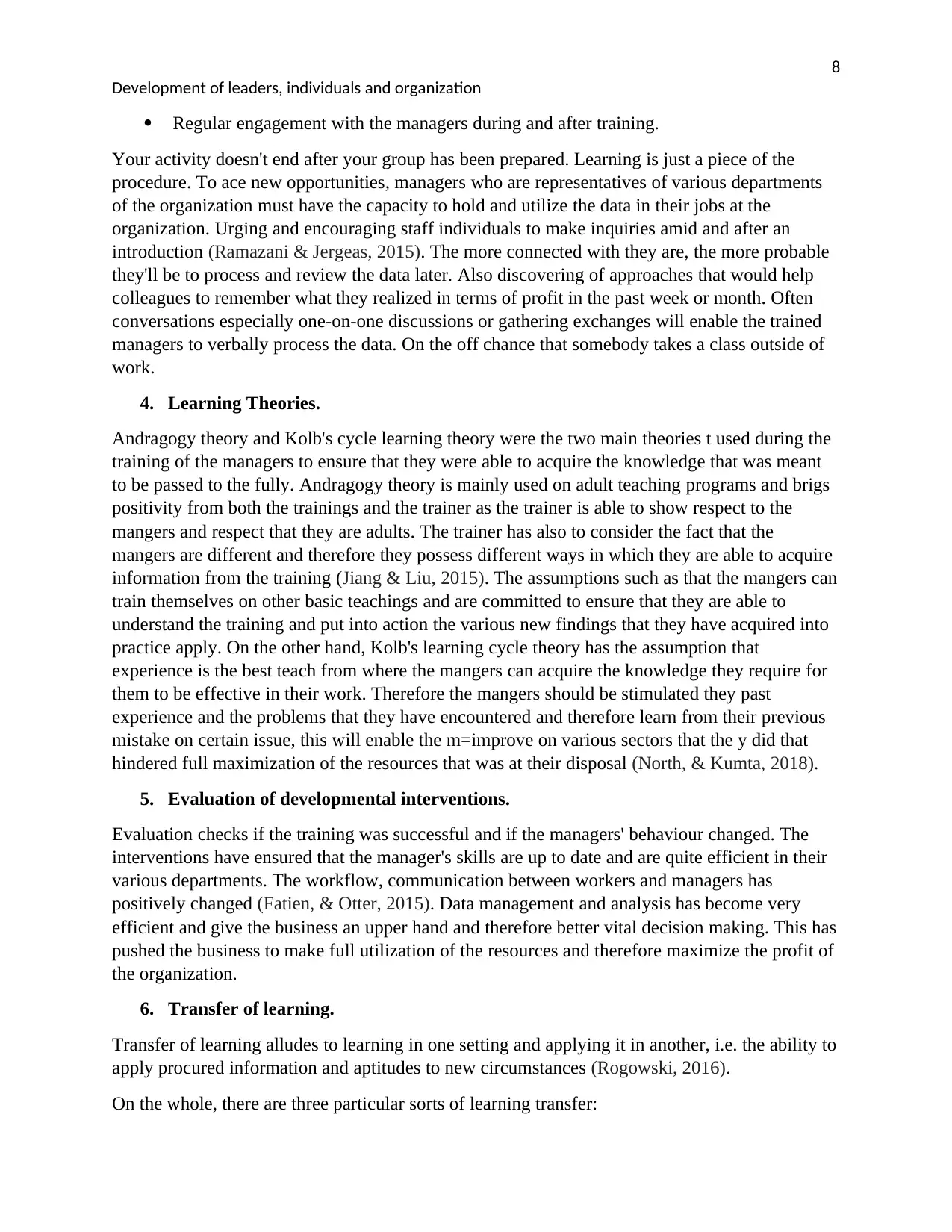
8
Development of leaders, individuals and organization
Regular engagement with the managers during and after training.
Your activity doesn't end after your group has been prepared. Learning is just a piece of the
procedure. To ace new opportunities, managers who are representatives of various departments
of the organization must have the capacity to hold and utilize the data in their jobs at the
organization. Urging and encouraging staff individuals to make inquiries amid and after an
introduction (Ramazani & Jergeas, 2015). The more connected with they are, the more probable
they'll be to process and review the data later. Also discovering of approaches that would help
colleagues to remember what they realized in terms of profit in the past week or month. Often
conversations especially one-on-one discussions or gathering exchanges will enable the trained
managers to verbally process the data. On the off chance that somebody takes a class outside of
work.
4. Learning Theories.
Andragogy theory and Kolb's cycle learning theory were the two main theories t used during the
training of the managers to ensure that they were able to acquire the knowledge that was meant
to be passed to the fully. Andragogy theory is mainly used on adult teaching programs and brigs
positivity from both the trainings and the trainer as the trainer is able to show respect to the
mangers and respect that they are adults. The trainer has also to consider the fact that the
mangers are different and therefore they possess different ways in which they are able to acquire
information from the training (Jiang & Liu, 2015). The assumptions such as that the mangers can
train themselves on other basic teachings and are committed to ensure that they are able to
understand the training and put into action the various new findings that they have acquired into
practice apply. On the other hand, Kolb's learning cycle theory has the assumption that
experience is the best teach from where the mangers can acquire the knowledge they require for
them to be effective in their work. Therefore the mangers should be stimulated they past
experience and the problems that they have encountered and therefore learn from their previous
mistake on certain issue, this will enable the m=improve on various sectors that the y did that
hindered full maximization of the resources that was at their disposal (North, & Kumta, 2018).
5. Evaluation of developmental interventions.
Evaluation checks if the training was successful and if the managers' behaviour changed. The
interventions have ensured that the manager's skills are up to date and are quite efficient in their
various departments. The workflow, communication between workers and managers has
positively changed (Fatien, & Otter, 2015). Data management and analysis has become very
efficient and give the business an upper hand and therefore better vital decision making. This has
pushed the business to make full utilization of the resources and therefore maximize the profit of
the organization.
6. Transfer of learning.
Transfer of learning alludes to learning in one setting and applying it in another, i.e. the ability to
apply procured information and aptitudes to new circumstances (Rogowski, 2016).
On the whole, there are three particular sorts of learning transfer:
Development of leaders, individuals and organization
Regular engagement with the managers during and after training.
Your activity doesn't end after your group has been prepared. Learning is just a piece of the
procedure. To ace new opportunities, managers who are representatives of various departments
of the organization must have the capacity to hold and utilize the data in their jobs at the
organization. Urging and encouraging staff individuals to make inquiries amid and after an
introduction (Ramazani & Jergeas, 2015). The more connected with they are, the more probable
they'll be to process and review the data later. Also discovering of approaches that would help
colleagues to remember what they realized in terms of profit in the past week or month. Often
conversations especially one-on-one discussions or gathering exchanges will enable the trained
managers to verbally process the data. On the off chance that somebody takes a class outside of
work.
4. Learning Theories.
Andragogy theory and Kolb's cycle learning theory were the two main theories t used during the
training of the managers to ensure that they were able to acquire the knowledge that was meant
to be passed to the fully. Andragogy theory is mainly used on adult teaching programs and brigs
positivity from both the trainings and the trainer as the trainer is able to show respect to the
mangers and respect that they are adults. The trainer has also to consider the fact that the
mangers are different and therefore they possess different ways in which they are able to acquire
information from the training (Jiang & Liu, 2015). The assumptions such as that the mangers can
train themselves on other basic teachings and are committed to ensure that they are able to
understand the training and put into action the various new findings that they have acquired into
practice apply. On the other hand, Kolb's learning cycle theory has the assumption that
experience is the best teach from where the mangers can acquire the knowledge they require for
them to be effective in their work. Therefore the mangers should be stimulated they past
experience and the problems that they have encountered and therefore learn from their previous
mistake on certain issue, this will enable the m=improve on various sectors that the y did that
hindered full maximization of the resources that was at their disposal (North, & Kumta, 2018).
5. Evaluation of developmental interventions.
Evaluation checks if the training was successful and if the managers' behaviour changed. The
interventions have ensured that the manager's skills are up to date and are quite efficient in their
various departments. The workflow, communication between workers and managers has
positively changed (Fatien, & Otter, 2015). Data management and analysis has become very
efficient and give the business an upper hand and therefore better vital decision making. This has
pushed the business to make full utilization of the resources and therefore maximize the profit of
the organization.
6. Transfer of learning.
Transfer of learning alludes to learning in one setting and applying it in another, i.e. the ability to
apply procured information and aptitudes to new circumstances (Rogowski, 2016).
On the whole, there are three particular sorts of learning transfer:
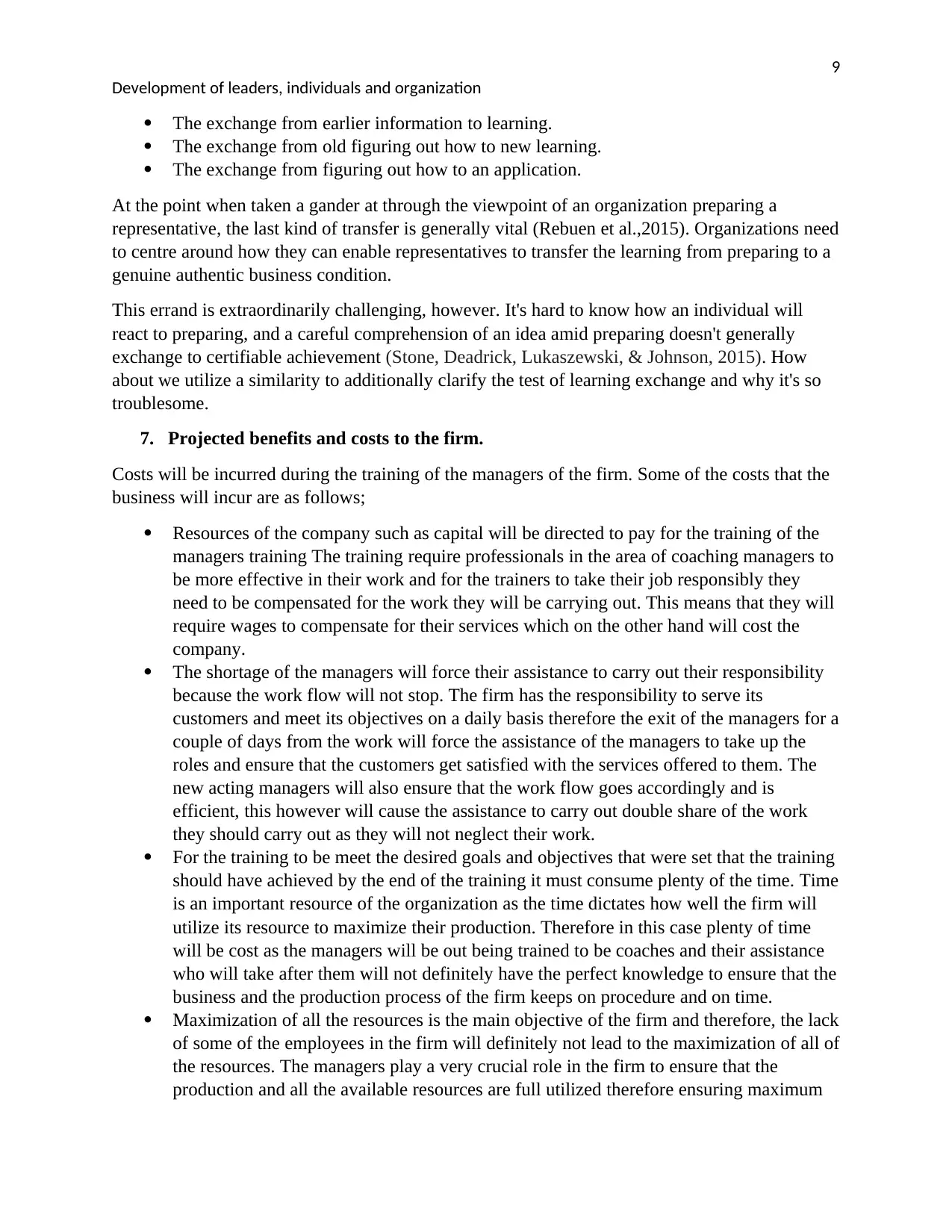
9
Development of leaders, individuals and organization
The exchange from earlier information to learning.
The exchange from old figuring out how to new learning.
The exchange from figuring out how to an application.
At the point when taken a gander at through the viewpoint of an organization preparing a
representative, the last kind of transfer is generally vital (Rebuen et al.,2015). Organizations need
to centre around how they can enable representatives to transfer the learning from preparing to a
genuine authentic business condition.
This errand is extraordinarily challenging, however. It's hard to know how an individual will
react to preparing, and a careful comprehension of an idea amid preparing doesn't generally
exchange to certifiable achievement (Stone, Deadrick, Lukaszewski, & Johnson, 2015). How
about we utilize a similarity to additionally clarify the test of learning exchange and why it's so
troublesome.
7. Projected benefits and costs to the firm.
Costs will be incurred during the training of the managers of the firm. Some of the costs that the
business will incur are as follows;
Resources of the company such as capital will be directed to pay for the training of the
managers training The training require professionals in the area of coaching managers to
be more effective in their work and for the trainers to take their job responsibly they
need to be compensated for the work they will be carrying out. This means that they will
require wages to compensate for their services which on the other hand will cost the
company.
The shortage of the managers will force their assistance to carry out their responsibility
because the work flow will not stop. The firm has the responsibility to serve its
customers and meet its objectives on a daily basis therefore the exit of the managers for a
couple of days from the work will force the assistance of the managers to take up the
roles and ensure that the customers get satisfied with the services offered to them. The
new acting managers will also ensure that the work flow goes accordingly and is
efficient, this however will cause the assistance to carry out double share of the work
they should carry out as they will not neglect their work.
For the training to be meet the desired goals and objectives that were set that the training
should have achieved by the end of the training it must consume plenty of the time. Time
is an important resource of the organization as the time dictates how well the firm will
utilize its resource to maximize their production. Therefore in this case plenty of time
will be cost as the managers will be out being trained to be coaches and their assistance
who will take after them will not definitely have the perfect knowledge to ensure that the
business and the production process of the firm keeps on procedure and on time.
Maximization of all the resources is the main objective of the firm and therefore, the lack
of some of the employees in the firm will definitely not lead to the maximization of all of
the resources. The managers play a very crucial role in the firm to ensure that the
production and all the available resources are full utilized therefore ensuring maximum
Development of leaders, individuals and organization
The exchange from earlier information to learning.
The exchange from old figuring out how to new learning.
The exchange from figuring out how to an application.
At the point when taken a gander at through the viewpoint of an organization preparing a
representative, the last kind of transfer is generally vital (Rebuen et al.,2015). Organizations need
to centre around how they can enable representatives to transfer the learning from preparing to a
genuine authentic business condition.
This errand is extraordinarily challenging, however. It's hard to know how an individual will
react to preparing, and a careful comprehension of an idea amid preparing doesn't generally
exchange to certifiable achievement (Stone, Deadrick, Lukaszewski, & Johnson, 2015). How
about we utilize a similarity to additionally clarify the test of learning exchange and why it's so
troublesome.
7. Projected benefits and costs to the firm.
Costs will be incurred during the training of the managers of the firm. Some of the costs that the
business will incur are as follows;
Resources of the company such as capital will be directed to pay for the training of the
managers training The training require professionals in the area of coaching managers to
be more effective in their work and for the trainers to take their job responsibly they
need to be compensated for the work they will be carrying out. This means that they will
require wages to compensate for their services which on the other hand will cost the
company.
The shortage of the managers will force their assistance to carry out their responsibility
because the work flow will not stop. The firm has the responsibility to serve its
customers and meet its objectives on a daily basis therefore the exit of the managers for a
couple of days from the work will force the assistance of the managers to take up the
roles and ensure that the customers get satisfied with the services offered to them. The
new acting managers will also ensure that the work flow goes accordingly and is
efficient, this however will cause the assistance to carry out double share of the work
they should carry out as they will not neglect their work.
For the training to be meet the desired goals and objectives that were set that the training
should have achieved by the end of the training it must consume plenty of the time. Time
is an important resource of the organization as the time dictates how well the firm will
utilize its resource to maximize their production. Therefore in this case plenty of time
will be cost as the managers will be out being trained to be coaches and their assistance
who will take after them will not definitely have the perfect knowledge to ensure that the
business and the production process of the firm keeps on procedure and on time.
Maximization of all the resources is the main objective of the firm and therefore, the lack
of some of the employees in the firm will definitely not lead to the maximization of all of
the resources. The managers play a very crucial role in the firm to ensure that the
production and all the available resources are full utilized therefore ensuring maximum
⊘ This is a preview!⊘
Do you want full access?
Subscribe today to unlock all pages.

Trusted by 1+ million students worldwide
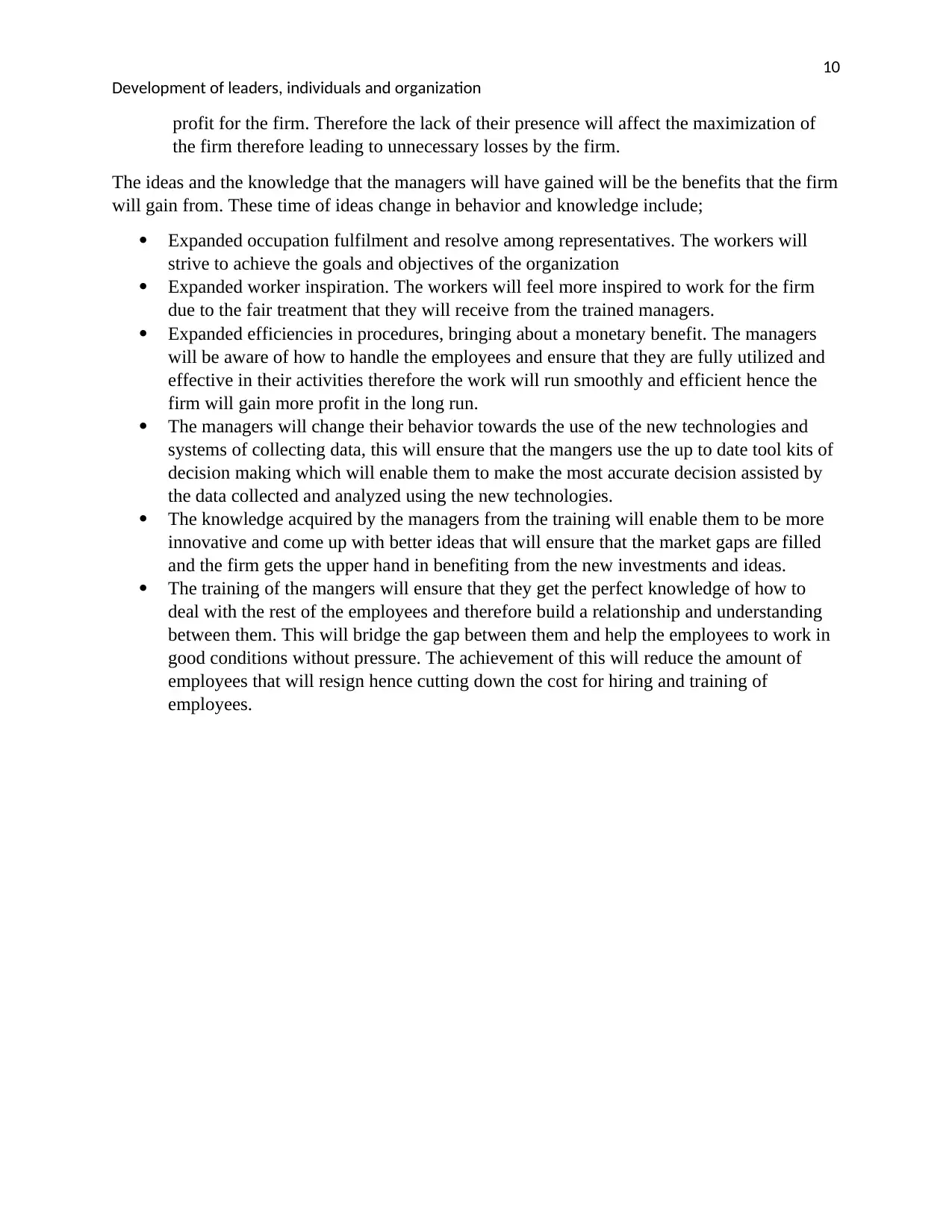
10
Development of leaders, individuals and organization
profit for the firm. Therefore the lack of their presence will affect the maximization of
the firm therefore leading to unnecessary losses by the firm.
The ideas and the knowledge that the managers will have gained will be the benefits that the firm
will gain from. These time of ideas change in behavior and knowledge include;
Expanded occupation fulfilment and resolve among representatives. The workers will
strive to achieve the goals and objectives of the organization
Expanded worker inspiration. The workers will feel more inspired to work for the firm
due to the fair treatment that they will receive from the trained managers.
Expanded efficiencies in procedures, bringing about a monetary benefit. The managers
will be aware of how to handle the employees and ensure that they are fully utilized and
effective in their activities therefore the work will run smoothly and efficient hence the
firm will gain more profit in the long run.
The managers will change their behavior towards the use of the new technologies and
systems of collecting data, this will ensure that the mangers use the up to date tool kits of
decision making which will enable them to make the most accurate decision assisted by
the data collected and analyzed using the new technologies.
The knowledge acquired by the managers from the training will enable them to be more
innovative and come up with better ideas that will ensure that the market gaps are filled
and the firm gets the upper hand in benefiting from the new investments and ideas.
The training of the mangers will ensure that they get the perfect knowledge of how to
deal with the rest of the employees and therefore build a relationship and understanding
between them. This will bridge the gap between them and help the employees to work in
good conditions without pressure. The achievement of this will reduce the amount of
employees that will resign hence cutting down the cost for hiring and training of
employees.
Development of leaders, individuals and organization
profit for the firm. Therefore the lack of their presence will affect the maximization of
the firm therefore leading to unnecessary losses by the firm.
The ideas and the knowledge that the managers will have gained will be the benefits that the firm
will gain from. These time of ideas change in behavior and knowledge include;
Expanded occupation fulfilment and resolve among representatives. The workers will
strive to achieve the goals and objectives of the organization
Expanded worker inspiration. The workers will feel more inspired to work for the firm
due to the fair treatment that they will receive from the trained managers.
Expanded efficiencies in procedures, bringing about a monetary benefit. The managers
will be aware of how to handle the employees and ensure that they are fully utilized and
effective in their activities therefore the work will run smoothly and efficient hence the
firm will gain more profit in the long run.
The managers will change their behavior towards the use of the new technologies and
systems of collecting data, this will ensure that the mangers use the up to date tool kits of
decision making which will enable them to make the most accurate decision assisted by
the data collected and analyzed using the new technologies.
The knowledge acquired by the managers from the training will enable them to be more
innovative and come up with better ideas that will ensure that the market gaps are filled
and the firm gets the upper hand in benefiting from the new investments and ideas.
The training of the mangers will ensure that they get the perfect knowledge of how to
deal with the rest of the employees and therefore build a relationship and understanding
between them. This will bridge the gap between them and help the employees to work in
good conditions without pressure. The achievement of this will reduce the amount of
employees that will resign hence cutting down the cost for hiring and training of
employees.
Paraphrase This Document
Need a fresh take? Get an instant paraphrase of this document with our AI Paraphraser
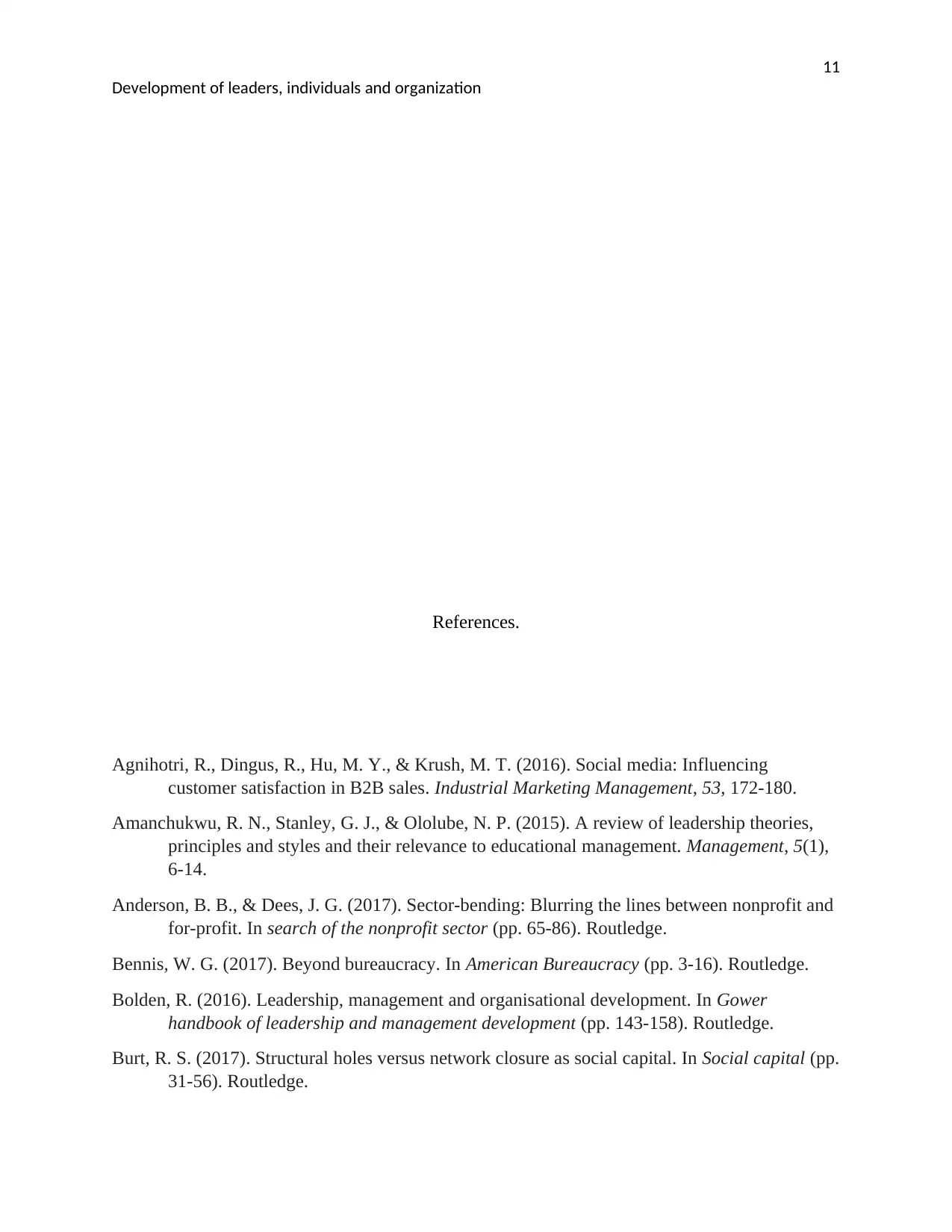
11
Development of leaders, individuals and organization
References.
Agnihotri, R., Dingus, R., Hu, M. Y., & Krush, M. T. (2016). Social media: Influencing
customer satisfaction in B2B sales. Industrial Marketing Management, 53, 172-180.
Amanchukwu, R. N., Stanley, G. J., & Ololube, N. P. (2015). A review of leadership theories,
principles and styles and their relevance to educational management. Management, 5(1),
6-14.
Anderson, B. B., & Dees, J. G. (2017). Sector-bending: Blurring the lines between nonprofit and
for-profit. In search of the nonprofit sector (pp. 65-86). Routledge.
Bennis, W. G. (2017). Beyond bureaucracy. In American Bureaucracy (pp. 3-16). Routledge.
Bolden, R. (2016). Leadership, management and organisational development. In Gower
handbook of leadership and management development (pp. 143-158). Routledge.
Burt, R. S. (2017). Structural holes versus network closure as social capital. In Social capital (pp.
31-56). Routledge.
Development of leaders, individuals and organization
References.
Agnihotri, R., Dingus, R., Hu, M. Y., & Krush, M. T. (2016). Social media: Influencing
customer satisfaction in B2B sales. Industrial Marketing Management, 53, 172-180.
Amanchukwu, R. N., Stanley, G. J., & Ololube, N. P. (2015). A review of leadership theories,
principles and styles and their relevance to educational management. Management, 5(1),
6-14.
Anderson, B. B., & Dees, J. G. (2017). Sector-bending: Blurring the lines between nonprofit and
for-profit. In search of the nonprofit sector (pp. 65-86). Routledge.
Bennis, W. G. (2017). Beyond bureaucracy. In American Bureaucracy (pp. 3-16). Routledge.
Bolden, R. (2016). Leadership, management and organisational development. In Gower
handbook of leadership and management development (pp. 143-158). Routledge.
Burt, R. S. (2017). Structural holes versus network closure as social capital. In Social capital (pp.
31-56). Routledge.
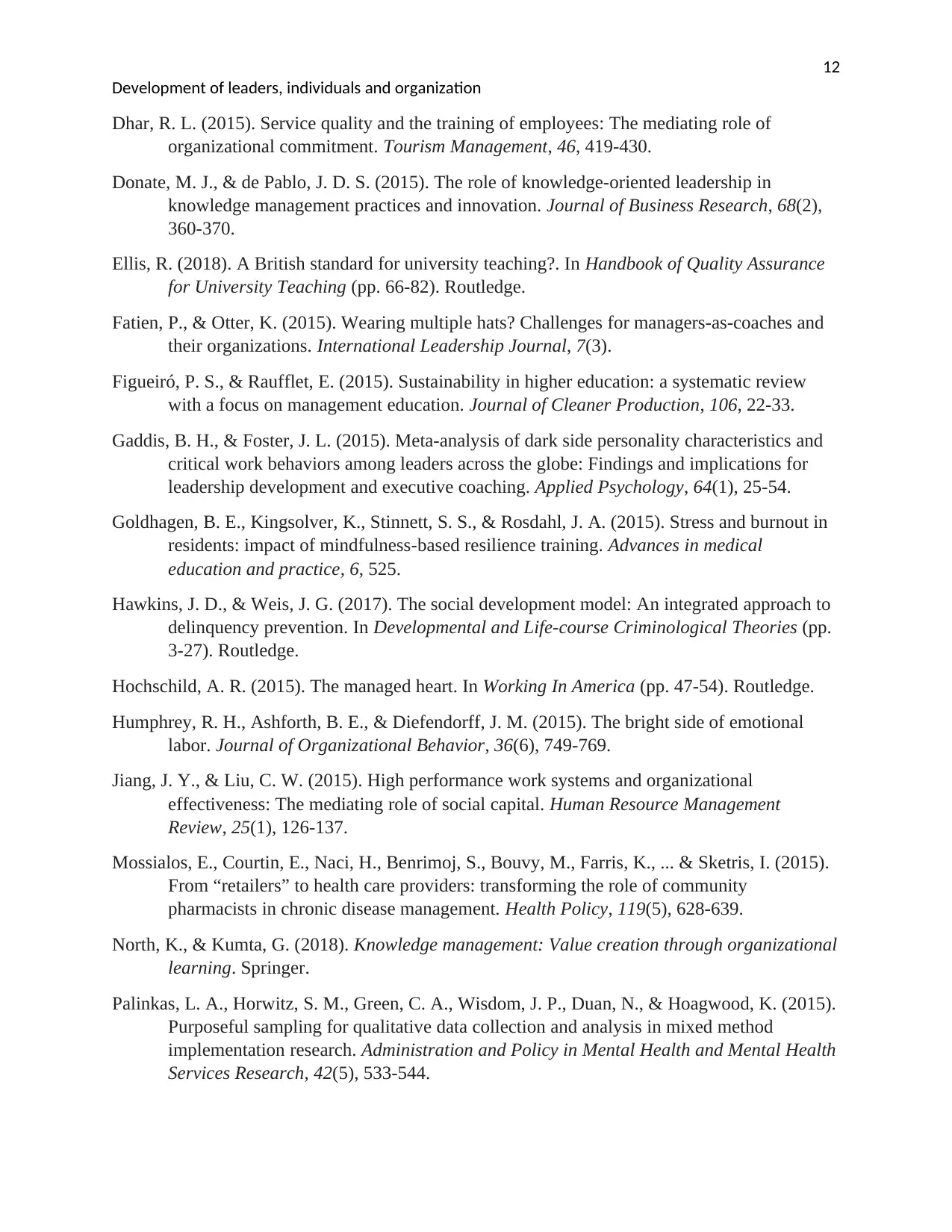
12
Development of leaders, individuals and organization
Dhar, R. L. (2015). Service quality and the training of employees: The mediating role of
organizational commitment. Tourism Management, 46, 419-430.
Donate, M. J., & de Pablo, J. D. S. (2015). The role of knowledge-oriented leadership in
knowledge management practices and innovation. Journal of Business Research, 68(2),
360-370.
Ellis, R. (2018). A British standard for university teaching?. In Handbook of Quality Assurance
for University Teaching (pp. 66-82). Routledge.
Fatien, P., & Otter, K. (2015). Wearing multiple hats? Challenges for managers-as-coaches and
their organizations. International Leadership Journal, 7(3).
Figueiró, P. S., & Raufflet, E. (2015). Sustainability in higher education: a systematic review
with a focus on management education. Journal of Cleaner Production, 106, 22-33.
Gaddis, B. H., & Foster, J. L. (2015). Meta‐analysis of dark side personality characteristics and
critical work behaviors among leaders across the globe: Findings and implications for
leadership development and executive coaching. Applied Psychology, 64(1), 25-54.
Goldhagen, B. E., Kingsolver, K., Stinnett, S. S., & Rosdahl, J. A. (2015). Stress and burnout in
residents: impact of mindfulness-based resilience training. Advances in medical
education and practice, 6, 525.
Hawkins, J. D., & Weis, J. G. (2017). The social development model: An integrated approach to
delinquency prevention. In Developmental and Life-course Criminological Theories (pp.
3-27). Routledge.
Hochschild, A. R. (2015). The managed heart. In Working In America (pp. 47-54). Routledge.
Humphrey, R. H., Ashforth, B. E., & Diefendorff, J. M. (2015). The bright side of emotional
labor. Journal of Organizational Behavior, 36(6), 749-769.
Jiang, J. Y., & Liu, C. W. (2015). High performance work systems and organizational
effectiveness: The mediating role of social capital. Human Resource Management
Review, 25(1), 126-137.
Mossialos, E., Courtin, E., Naci, H., Benrimoj, S., Bouvy, M., Farris, K., ... & Sketris, I. (2015).
From “retailers” to health care providers: transforming the role of community
pharmacists in chronic disease management. Health Policy, 119(5), 628-639.
North, K., & Kumta, G. (2018). Knowledge management: Value creation through organizational
learning. Springer.
Palinkas, L. A., Horwitz, S. M., Green, C. A., Wisdom, J. P., Duan, N., & Hoagwood, K. (2015).
Purposeful sampling for qualitative data collection and analysis in mixed method
implementation research. Administration and Policy in Mental Health and Mental Health
Services Research, 42(5), 533-544.
Development of leaders, individuals and organization
Dhar, R. L. (2015). Service quality and the training of employees: The mediating role of
organizational commitment. Tourism Management, 46, 419-430.
Donate, M. J., & de Pablo, J. D. S. (2015). The role of knowledge-oriented leadership in
knowledge management practices and innovation. Journal of Business Research, 68(2),
360-370.
Ellis, R. (2018). A British standard for university teaching?. In Handbook of Quality Assurance
for University Teaching (pp. 66-82). Routledge.
Fatien, P., & Otter, K. (2015). Wearing multiple hats? Challenges for managers-as-coaches and
their organizations. International Leadership Journal, 7(3).
Figueiró, P. S., & Raufflet, E. (2015). Sustainability in higher education: a systematic review
with a focus on management education. Journal of Cleaner Production, 106, 22-33.
Gaddis, B. H., & Foster, J. L. (2015). Meta‐analysis of dark side personality characteristics and
critical work behaviors among leaders across the globe: Findings and implications for
leadership development and executive coaching. Applied Psychology, 64(1), 25-54.
Goldhagen, B. E., Kingsolver, K., Stinnett, S. S., & Rosdahl, J. A. (2015). Stress and burnout in
residents: impact of mindfulness-based resilience training. Advances in medical
education and practice, 6, 525.
Hawkins, J. D., & Weis, J. G. (2017). The social development model: An integrated approach to
delinquency prevention. In Developmental and Life-course Criminological Theories (pp.
3-27). Routledge.
Hochschild, A. R. (2015). The managed heart. In Working In America (pp. 47-54). Routledge.
Humphrey, R. H., Ashforth, B. E., & Diefendorff, J. M. (2015). The bright side of emotional
labor. Journal of Organizational Behavior, 36(6), 749-769.
Jiang, J. Y., & Liu, C. W. (2015). High performance work systems and organizational
effectiveness: The mediating role of social capital. Human Resource Management
Review, 25(1), 126-137.
Mossialos, E., Courtin, E., Naci, H., Benrimoj, S., Bouvy, M., Farris, K., ... & Sketris, I. (2015).
From “retailers” to health care providers: transforming the role of community
pharmacists in chronic disease management. Health Policy, 119(5), 628-639.
North, K., & Kumta, G. (2018). Knowledge management: Value creation through organizational
learning. Springer.
Palinkas, L. A., Horwitz, S. M., Green, C. A., Wisdom, J. P., Duan, N., & Hoagwood, K. (2015).
Purposeful sampling for qualitative data collection and analysis in mixed method
implementation research. Administration and Policy in Mental Health and Mental Health
Services Research, 42(5), 533-544.
⊘ This is a preview!⊘
Do you want full access?
Subscribe today to unlock all pages.

Trusted by 1+ million students worldwide
1 out of 19
Related Documents
Your All-in-One AI-Powered Toolkit for Academic Success.
+13062052269
info@desklib.com
Available 24*7 on WhatsApp / Email
![[object Object]](/_next/static/media/star-bottom.7253800d.svg)
Unlock your academic potential
Copyright © 2020–2025 A2Z Services. All Rights Reserved. Developed and managed by ZUCOL.




